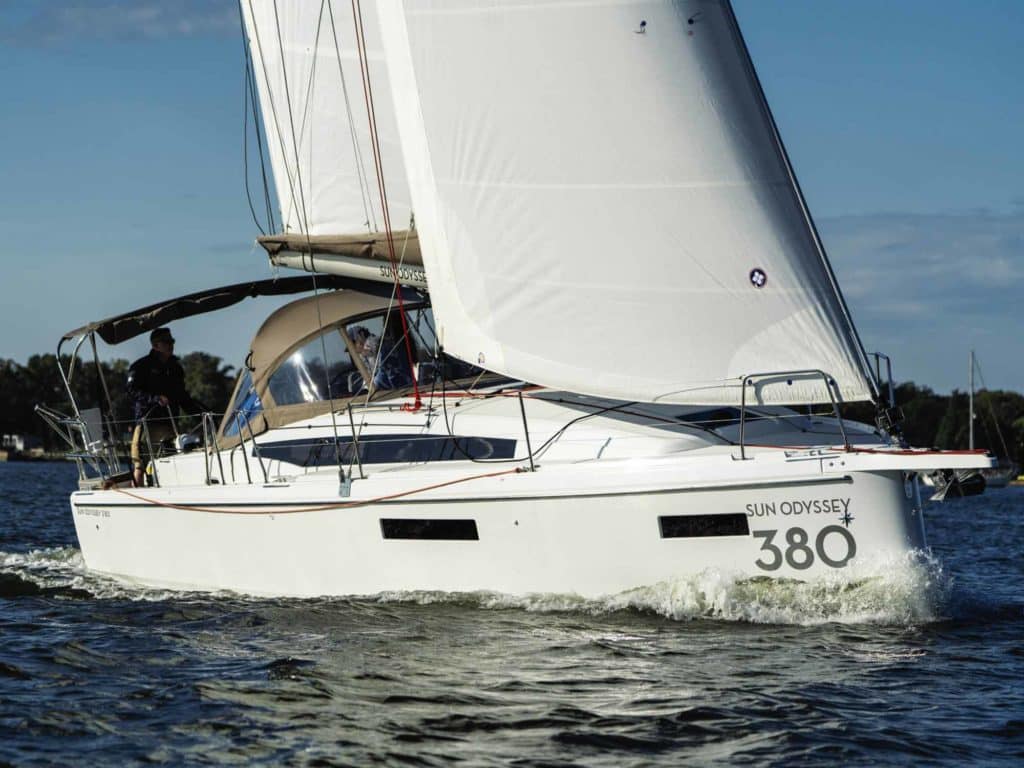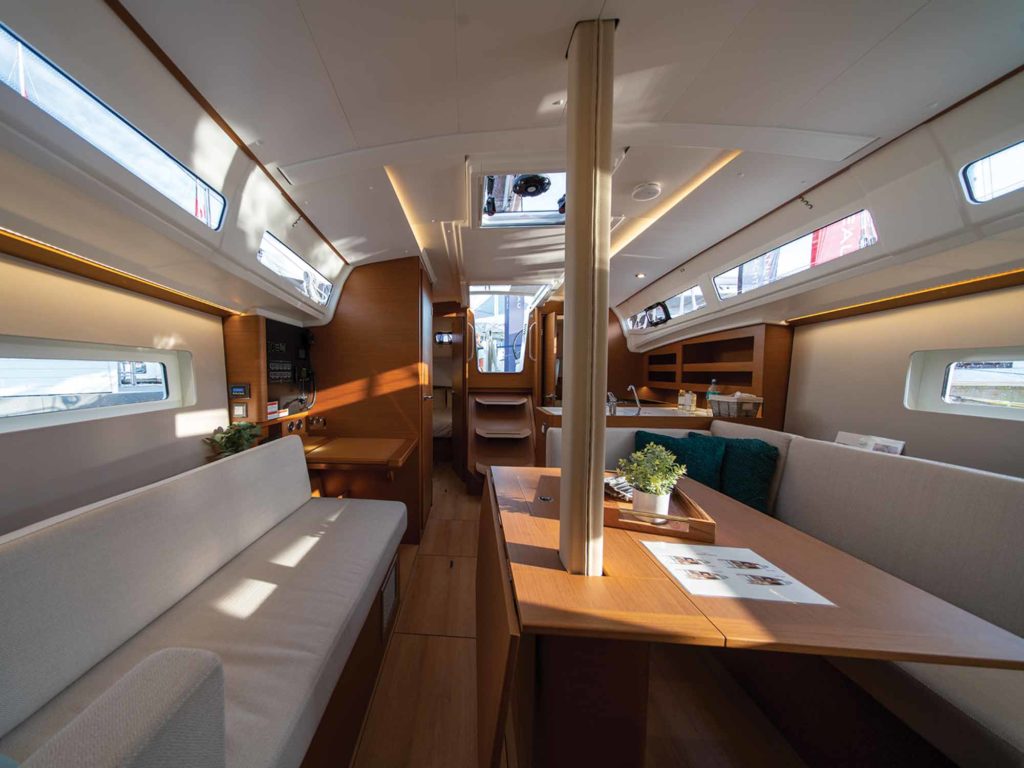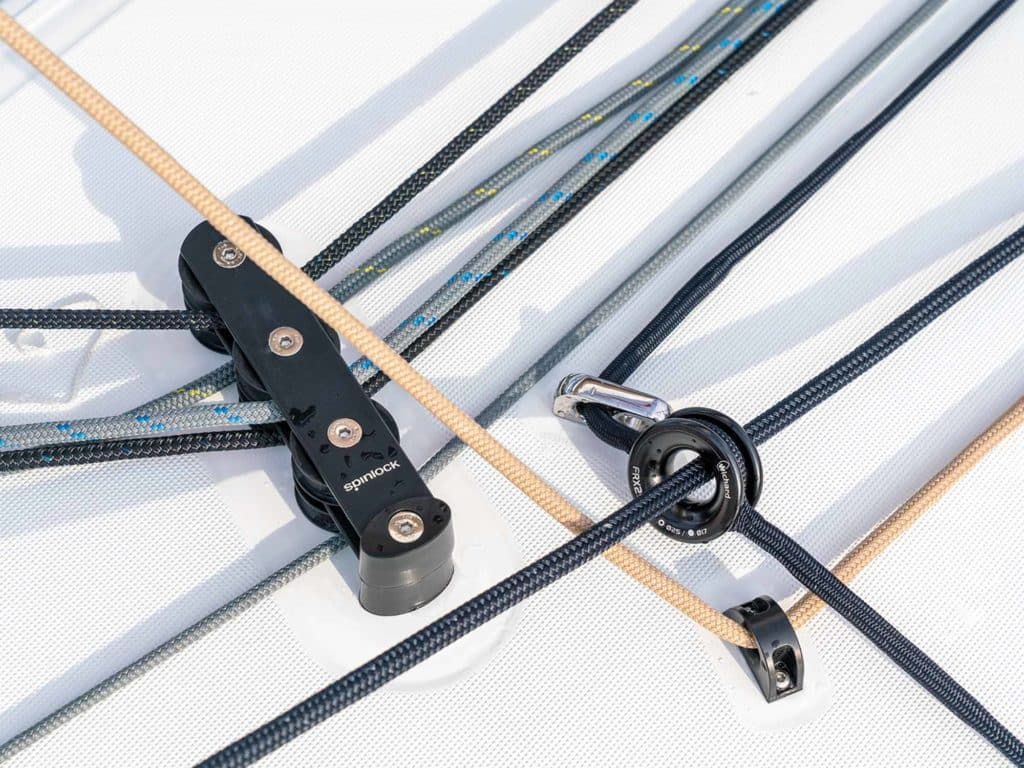
First impressions count, and mine were definitely favorable as I approached the Jeanneau Sun Odyssey 380 with CW’s Boat of the Year judges during October’s United States Sailboat Show in Annapolis, Maryland. Something about the way the reverse bow’s knuckle hovered just above the water caught my eye. Toss in pronounced hull chines carried aft from amidships, a low-slung coachroof and a high-aspect rig, and this boat hinted at the potential for some serious giddyap-and-go.
And it did, as we found out a few days later, when we went for a sail on a delightfully sunny morning on Chesapeake Bay.
The breeze was decent, about 15 knots. Sailing hard on the wind, we saw 7 knots and change on the GPS; we pushed it past 8 knots when we cracked off to a close reach. The 380 comes with a sprit that does double duty as an anchor roller and tack for off-wind sails, but a code zero wasn’t available (or we might have bumped the speedo by another knot or so while reaching deeper).
Judge Tim Murphy summed up our time aboard fairly well later in the day: “It really was a lovely boat to sail. Boy, we got out there this morning; the breeze was light, and you really, really felt the pleasure of going sailing. That’s quite successful.”
After my trick at the wheel, I wrote in my notes, “super-responsive.” Naval architect Mark Lombard knows how to draw slippery hulls, and with twin rudders, the 380 immediately zigged and zagged with just a turn of the wheel. I believe they call it fingertip steering.
The helms are far aft in the cockpit, adjacent to the manual fold-down transom/swim platform, and there is a clean path between them. This design allows the helmsman to move easily from side to side. I had no problem tacking the boat single-handed, releasing the loaded-up genoa sheet and the crossing to trim to the new heading. A single Harken sheet winch was just forward of either wheel. Another pair of Harken winches was on the cabin top, to either side of the companionway, for halyards, reef lines and a vang control.
The 380 uses a double-ended main sheet attached to a bridle with anchors on either side of the cabin top. Sheet ends are led to stoppers at either wheel so that they can be locked off and the coaming winches can be used for genoa trimming. Rather than using fairlead cars and tracks, the genoa jib sheets are led through friction rings on either side of the mast. The rings are each controlled by inhaul and outhaul lines, which means you can position the clew where you want it and really fine-tune sail shape. It takes a little getting used to, but it’s a pretty nifty feature. The boat we sailed was set up with a 110 percent genoa on a roller furler; a track for a self-tacking jib is an option.
Forward of the helms, the 380 has a roomy, well-laid-out cockpit. A centerline table has fiberglass leaves that drop to allow a clear path forward to either side, and its stainless-steel tube frame provides a solid handhold. The boat we visited had cushions on the coamings and seats, and the benches were long enough for the off-watch crew to stretch out and grab some rest.
A few years ago, Jeanneau introduced walkaround decks to the Sun Odyssey line, and the builder has now brought this concept to the 380, likely the smallest boat that will see it. The side decks ramp down to the level of the cockpit sole, so you just have to walk out from either wheel and then forward up a relatively gentle incline. Besides ease of use for older crew, the arrangement means the lifeline and stern pulpit are about waist-high at the after end of the boat (good for safety as well). Forward of about amidships, the lifelines are at their typical 24-inch height. Thick, molded toe rails help keep feet from sliding overboard when the boat’s heeling.
Two last notes about the topsides: The 380 has no backstay, meaning an owner can hoist a square top main for added performance (our boat had a traditional main, stowed in a boom pouch when not in use). The trade-off is relatively low lower shrouds that need to be ducked when heading for the foredeck, though the low coachroof makes stepping up and past them tolerable.

Down below, the 380 has a fairly traditional layout by Jean-Marc Piaton, who’s had a hand in styling the entire Sun Odyssey range. A centerline drop-leaf table is forward in the saloon, surrounded by U-shaped seating to port; opposite is a long settee, with a kind of cool inboard armrest at its forward end. It lets you face aft and relax, or turn to converse with mates across the table. At the opposite end are a nav station and the boat’s electrical panel.
The galley is abaft the dinette. It has a gimbaled propane two-burner stove and oven, as well as generous refrigeration space. The counters have deep fiddles, and there’s enough stowage to provision for extended time at sea.
There are multiple options for sleeping accommodations. The boat we saw had a three-stateroom, two-head layout, with a shared head and shower compartment to starboard, at the foot of the companionway. With the two-stateroom, one-head arrangement, you gain a second hanging locker in the owner’s stateroom forward, and the stateroom aft and to starboard is reconfigured for a separate shower, as well as room for a workshop or stowage. If it were my boat, that’s what I’d choose.

Jeanneau injects the balsa-cored deck of the 380, which means there is a finished top and bottom surface when it comes out of the mold. The hull is hand-laid and solid fiberglass. There are two cast-iron fixed keels available: shoal draft (5 feet, 3 inches) and standard (6 feet, 6 inches). There’s also a lifting keel option. At 54 feet, 6 inches, the rig is Intracoastal Waterway-friendly. Our boat had a 29 hp Yanmar and shaft drive (a 40 hp Yanmar is optional). A base-model SO 380 starts at $237,000. The boat we sailed, with canvas, air conditioning, electronics and a stereo system among the options, will run you about $350,000, delivered and commissioned to the East Coast of the United States.
Though I began with a nod to first impressions, my lasting impression of the Jeanneau Sun Odyssey 380 is favorable too. Or, as Boat of the Year judge Ed Sherman put it,
“Yeah, cool boat.”
Mark Pillsbury is a CW editor-at-large.
Jeanneau Sun Odyssey 380 Specifications
| LENGTH OVERALL | 38’6″ (11.73 m) |
| WATERLINE LENGTH | 35’1″ (10.69 m) |
| BEAM | 12’3″ (3.73 m) |
| DRAFT (standard/shoal) | 6’6″/5’3″ (1.98 m/1.60 m) |
| SAIL AREA | 704 sq. ft. (64.4 sq. m) |
| BALLAST (standard/shoal) | 3,990 lb./4,348 lb./ (1,810 kg/1,972 kg) |
| DISPLACEMENT | 15,203 lb. (6,896 kg) |
| BALLAST/DISPLACEMENT | 0.26 (0.29 shoal) |
| DISPLACEMENT/LENGTH | 157 |
| SAIL AREA/DISPLACEMENT | 18.4 |
| WATER | 87 gal. (329 L) |
| FUEL | 34 gal. (129 L) |
| HOLDING | 21 gal. (79 L) |
| MAST HEIGHT | 54’6″ (16.61 m) |
| ENGINE | 29 hp Yanmar |
| DESIGNER | Marc Lombard Yacht Design |
| Piaton Bercault & Co. | |
| Jeanneau Design | |
| PRICE | $350,000 |
| Jeanneau | 443-221-4203 |
Sea Trial
| WIND SPEED | 14-17 knots |
|---|---|
| SEA STATE | Light chop |
| SAILING | Closehauled 7 |
| Reaching 8.4 | |
| MOTORING | Cruise (2,300 rpm) 6.5 knots |
| Fast (2,800 rpm) 8.7 knots |
For a complete guide to Cruising World’s extensive online catalog of boat reviews, or to request reprints from our older print archives of reviews, go to cruisingworld.com/sailboats.








